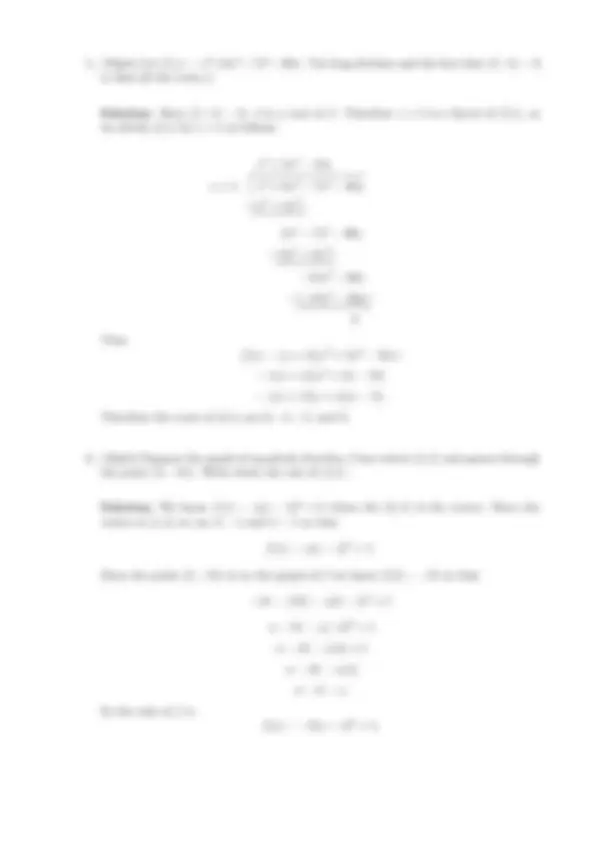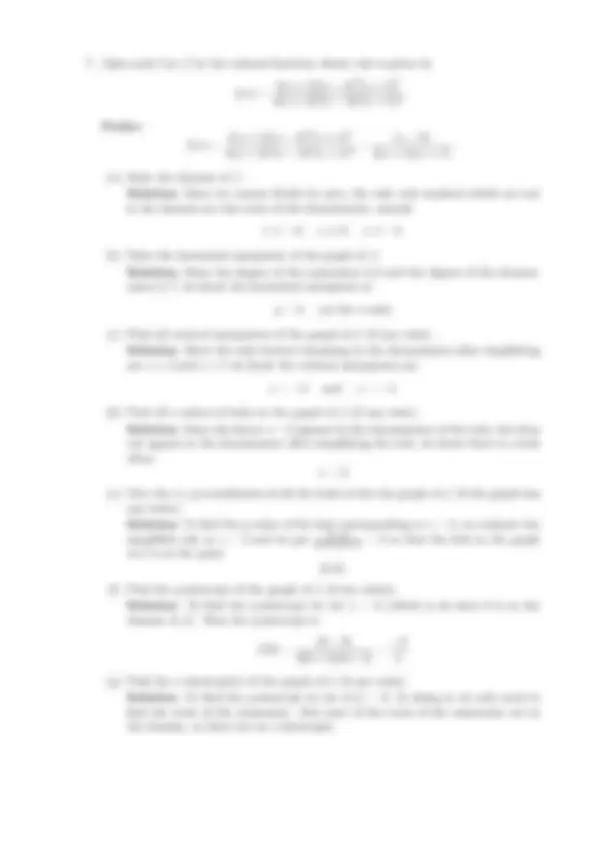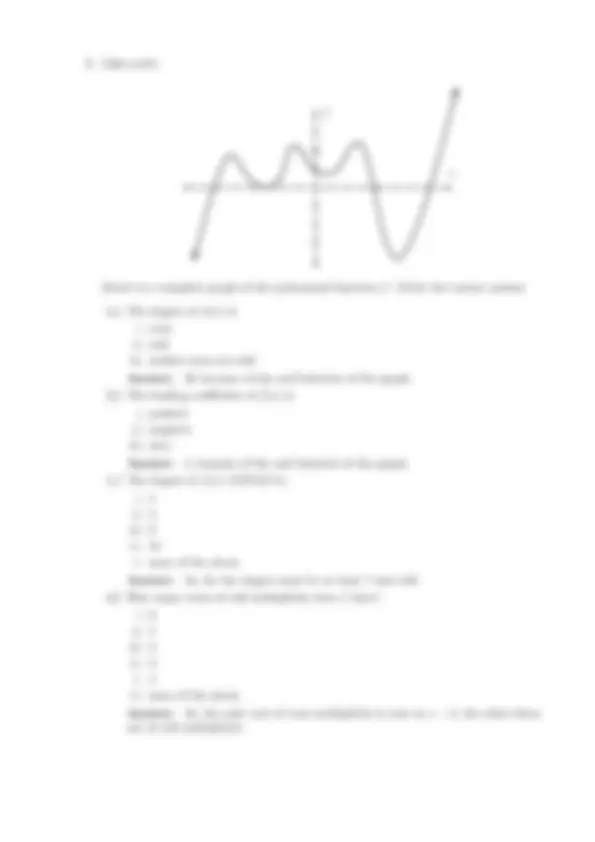





Study with the several resources on Docsity

Earn points by helping other students or get them with a premium plan


Prepare for your exams
Study with the several resources on Docsity

Earn points to download
Earn points by helping other students or get them with a premium plan
Community
Ask the community for help and clear up your study doubts
Discover the best universities in your country according to Docsity users
Free resources
Download our free guides on studying techniques, anxiety management strategies, and thesis advice from Docsity tutors
Material Type: Exam; Class: College Algebra >5; Subject: Mathematics; University: University of Oregon; Term: Unknown 1989;
Typology: Exams
1 / 6

This page cannot be seen from the preview
Don't miss anything!




Math 111–Exam 2 Solutions
(a) A polynomial function of degree 7 can have 6 real roots. True, for a polynomial function of degree 7 has at most 7 real roots, and 6 < 7. (b) If x + 1 is a factor of a polynomial function f (x), then x − 1 is also a factor of f (x). False, for example the polynomial functions with rules f (x) = x^2 + x, f (x) = (x + 1)(x − 2)^2 , and f (x) = x + 1 all have x + 1 as a factor but do not have x − 1 as a factor. (There are many more counterexamples). (c) x + 1 is a factor of x^4 − 15 x − 16. True, for (−1)^4 − 15(−1) − 16 = 0 so −1 is a root of x^4 − 15 x − 16. Thus x − (−1) = x + 1 is a factor of x^4 − 15 x − 16. (d) The range of some quadratic functions is (−∞, ∞). False, for all quadratic functions have either a minimum or a maximum value (the y-coordinate of the vertex). If the function has a minimum value, then no real number less than that value is in the range. Similarly if the function has a maximum value, then no real number greater than that value is in the range.
Solution: First we consider the equation |x^2 − 1 | = 8. To solve for x we must solve the two equations x^2 − 1 = 8 and x^2 − 1 = − 8. Solving for x in the first equation we see
x^2 − 1 = 8 ⇒ x^2 = 9 ⇒ x = ± 3.
Solving for x in the second equation we see
x^2 − 1 = − 8 ⇒ x^2 = − 7 ⇒ x = ±
which is not a real number, thus there are no real solutions to the second equation. Now we must check one point in each of the intervals (−∞, −3), (− 3 , 3), and (3, ∞) in the original inequality. I will check − 4 , 0, and 4.
Since
|(−4)^2 − 1 | = 15 6 ≤ 8 and |(0)^2 − 1 | = 1 ≤ 8 and |(4)^2 − 1 | = 15 6 ≤ 8
we see the solution is
or in interval notation [− 3 , 3].
Solution: The rule f (t) = 400
)t
gives the amount of money in my account after t quarters. Since there are 12 quarters in 3 years we see that after 3 years I will have
f (12) = 400
dollars in my account.
Solution: Since l + 3w = 12 we know l = 12 − 3 w, so we have
A = lw = (12 − 3 w)w = − 3 w^2 + 12w.
To find the maximal area, we must find the vertex of the parabola which is the graph of the equation A = − 3 w^2 + 12w. Notice
A = − 3 w^2 + 12w
= w^2 − 4 w
= w^2 − 4 w + 4
= (w − 2)^2
= (w − 2)^2 − 4
⇒ A = −3(w − 2)^2 + 12. Thus the vertex is (2, 12), which tells us the maximum area occurs when the width is 2, and the maximal area is 12.
f (x) =
4(x + 2)(x − 3)^3 (x + 1)^2 8(x + 2)^2 (x − 3)^2 (x + 1)^3
Notice: f (x) =
4(x + 2)(x − 3)^3 (x + 1)^2 8(x + 2)^2 (x − 3)^2 (x + 1)^3
(x − 3) 2(x + 2)(x + 1)
(a) State the domain of f. Solution: Since we cannot divide by zero, the only real numbers which are not in the domain are the roots of the denominator, namely
x 6 = − 2 , x 6 = 3, x 6 = − 1.
(b) State the horizontal asymptote of the graph of f. Solution: Since the degree of the numerator is 6 and the degree of the denomi- nator is 7, we know the horizontal asymptote is
y = 0 (or the x-axis)
(c) Find all vertical asymptotes of the graph of f (if any exist). Solution: Since the only factors remaining in the denominator after simplifying are x + 2 and x + 1 we know the vertical asymptotes are
x = − 2 and x = − 1.
(d) Find all x-values of holes in the graph of f (if any exist). Solution: Since the factor x − 3 appears in the denominator of the rule, but does not appear in the denominator after simplifying the rule, we know there is a hole when x = 3. (e) Give the (x, y)-coordinates of all the holes of the the graph of f (if the graph has any holes). Solution: To find the y-value of the hole corresponding to x = 3, we evaluate the simplified rule at x = 3 and we get (^) 2(3+2)(3+1)(3−3) = 0 so that the hole in the graph of f is at the point (3, 0). (f) Find the y-intercept of the graph of f (if one exists). Solution: To find the y-intercept we set x = 0 (which is ok since 0 is in the domain of f ). Thus the y-intercept is
f (0) =
(g) Find the x-intercept(s) of the graph of f (if any exist). Solution: To find the y-intercept we set f (x) = 0. In doing so we only need to find the roots of the numerator. But none of the roots of the numerator are in the domain, so there are no x-intercepts.
y
x
Above is a complete graph of the polynomial function f. Circle the correct answer.
(a) The degree of f (x) is i. even ii. odd iii. neither even nor odd Answer: ii, because of the end behavior of the graph. (b) The leading coefficient of f (x) is i. positive ii. negative iii. zero Answer: i, because of the end behavior of the graph. (c) The degree of f (x) COULD be i. 4 ii. 5 iii. 8 iv. 11 v. none of the above Answer: iv, for the degree must be at least 7 and odd. (d) How many roots of odd multiplicity does f have? i. 0 ii. 1 iii. 2 iv. 3 v. 4 vi. none of the above Answer: iv, the only root of even multiplicity is root at x = 3, the other three are of odd multiplicity.